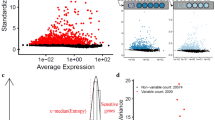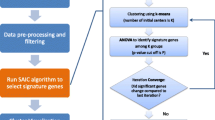Abstract
Single-cell RNA-seq (scRNA-seq) allows the analysis of gene expression in each cell, which enables the detection of highly variable genes (HVG) that contribute to cell-to-cell variation within a homogeneous cell population. HVG detection is necessary for clustering analysis to improve the clustering result. scRNA-seq includes some genes that are expressed with a certain probability in all cells which make the cells indistinguishable. These genes are referred to as background noise. To remove the background noise and select the informative genes for clustering analysis, in this paper, we propose an effective HVG detection method based on principal component analysis (PCA). The proposed method utilizes PCA to evaluate the genes (features) on the sample space. The distortion-free principal components are selected to calculate the distance from the origin to gene as the weight of each gene. The genes that have the greatest distances to the origin are selected for clustering analysis. Experimental results on both synthetic and gene expression datasets show that the proposed method not only removes the background noise to select the informative genes for clustering analysis, but also outperforms the existing HVG detection methods.
Similar content being viewed by others
References
Oshlack A, Robinson M D, Young M D. From RNA-seq reads to differential expression results. Genome Biology, 2010, 11(12): 220
Ye X, Zhang W, Sakurai T. Adaptive unsupervised feature learning for gene signature identification in non-small-cell lung cancer. IEEE Access, 2020, 8: 154354–154362
Ozsolak F, Milos P M. RNA sequencing: advances, challenges and opportunities. Nature Reviews Genetics, 2011, 12(2): 87–98
Wagner A, Regev A, Yosef N. Revealing the vectors of cellular identity with single-cell genomics. Nature Biotechnology, 2016, 34(11): 1145–1160
Kiselev V Y, Andrews T S, Hemberg M. Challenges in unsupervised clustering of single-cell RNA-seq data. Nature Reviews Genetics, 2019, 20(5): 273–282
Ye X, Zhang W, Futamura Y, Sakurai T. Detecting interactive gene groups for single-cell RNA-Seq data based on co-expression network analysis and subgraph learning. Cells, 2020, 9(9): 1938
Ye X, Sakurai T. Robust similarity measure for spectral clustering based on shared neighbors. ETRI Journal, 2016, 38(3): 540–550
Emmert-Streib F, Dehmer M, Haibe-Kains B. Gene regulatory networks and their applications: understanding biological and medical problems in terms of networks. Frontiers in Cell and Developmental Biology, 2014, 2: 38
Thompson D, Regev A, Roy S. Comparative analysis of gene regulatory networks: from network reconstruction to evolution. Annual Review of Cell and Developmental Biology, 2015, 31: 399–428
Ye X, Sakurai T. Spectral clustering with adaptive similarity measure in Kernel space. Intelligent Data Analysis, 2018, 22(4): 751–765
Yip S H, Sham P C, Wang J. Evaluation of tools for highly variable gene discovery from single-cell RNA-seq data. Briefings in Bioinformatics, 2019, 20(4): 1583–1589
Finak G, McDavid A, Yajima M, Deng J, Gersuk V, Shalek A K, Slichter C K, Miller H W, McElrath M J, Prlic M, Linsley P S, Gottardo R. MAST: a flexible statistical framework for assessing transcriptional changes and characterizing heterogeneity in single-cell RNA sequencing data. Genome Biology, 2015, 16: 278
Yip S H, Wang P, Kocher J P A, Sham P C, Wang J. Linnorm: improved statistical analysis for single cell RNA-seq expression data. Nucleic Acids Research, 2017, 45(22): e179
Law C W, Chen Y, Shi W, Smyth G K. Voom: precision weights unlock linear model analysis tools for RNA-seq read counts. Genome Biology, 2014, 15(2): R29
Vallejos C A, Marioni J C, Richardson S. BASiCS: bayesian analysis of single-cell sequencing data. PLoS Computational Biology, 2015, 11(6): e1004333
Lun A T L, Bach K, Marioni J C. Pooling across cells to normalize single-cell RNA sequencing data with many zero counts. Genome Biology, 2016, 17: 75
Lun A T L, McCarthy D J, Marioni J C. A step-by-step workflow for low-level analysis of single-cell RNA-seq data with Bioconductor. F1000Research, 2016, 5: 2122
Brennecke P, Anders S, Kim J K, Kolodziejczyk A A, Zhang X W, Proserpio V, Baying B, Benes V, Teichmann S A, Marioni J C, Heisler M G. Accounting for technical noise in single-cell RNA-seq experiments. Nature Methods, 2013, 10(11): 1093–1095
Chen H I H, Jin Y, Huang Y, Chen Y. Detection of high variability in gene expression from single-cell RNA-seq profiling. BMC Genomics, 2016, 17(S7): 508
Guyon I, Weston J, Barnhill S, Vapnik V. Gene selection for cancer classification using support vector machines. Machine Learning, 2002, 46(1–3): 389–422
Díaz-Uriarte R, de Andrés S A. Gene selection and classification of microarray data using random forest. BMC Bioinformatics, 2006, 7: 3
Satija R, Farrell J A, Gennert D, Schier A F, Regev A. Spatial reconstruction of single-cell gene expression data. Nature Biotechnology, 2015, 33(5): 495–502
Stuart T, Butler A, Hoffman P, Hafemeister C, Papalexi E, MauckIII W M, Hao Y, Stoeckius M, Smibert P, Satija R. Comprehensive integration of single-cell data. Cell, 2019, 177(7): 1888–1902.e21
Mayer C, Hafemeister C, Bandler R C, Machold R, Brito R B, Jaglin X, Allaway K, Butler A, Fishell G, Satija R. Developmental diversification of cortical inhibitory interneurons. Nature, 2018, 555(7697): 457–462
Hotelling H. Analysis of a complex of statistical variables into principal components. Journal of Educational Psychology, 1993, 24(6): 417–441
Jolliffe I T. Principal Component Analysis. Springer, 1986
Pearson K. On the criterion that a given system of deviations from the probable in the case of a correlated system of variables is such that it can be reasonably supposed to have arisen from random sampling. In: Kotz S, Johnson N L, eds. Breakthroughs in Statistics. New York: Springer, 1992
Heckert N A, Filliben J J. NIST/SEMATECH e-Handbook of statistical methods; Chapter 1: Exploratory Data Analysis. 2003
Gierahn T M, WadsworthII M H, Hughes T K, Bryson B D, Butler A, Satija R, Fortune S, Love J C, Shalek A K. Seq-Well: portable, low-cost RNA sequencing of single cells at high throughput. Nature Methods, 2017, 14(4): 395–398
Liu A H, Nowakowski T J, Pollen A A, Lui J H, Horlbeck M A, Attenello F J, He D, Weissman J S, Kriegstein A R, Diaz A A, Lim D A. Single-cell analysis of long non-coding RNAs in the developing human neocortex. Genome Biology, 2016, 17: 67
Pollen A A, Nowakowski T J, Shuga J, Wang X, Leyrat A A, et al. Low-coverage single-cell mRNA sequencing reveals cellular heterogeneity and activated signaling pathways in developing cerebral cortex. Nature Biotechnology, 2014, 32(10): 1053–1058
Hafemeister C, Satija R. Normalization and variance stabilization of single-cell RNA-seq data using regularized negative binomial regression. Genome Biology, 2019, 20(1): 296
Rand W M. Objective criteria for the evaluation of clustering methods. Journal of the American Statistical Association, 1971, 66(336): 846–850
McInnes L, Healy J, Saul N, Großberger L. UMAP: uniform manifold approximation and projection. The Journal of Open Source Software, 2018, 3(29): 861
Acknowledgements
This study was supported in part by the New Energy and Industrial Technology Development Organization (AJD30064) and JST COI-NEXT.
Author information
Authors and Affiliations
Corresponding authors
Additional information
Momo Matsuda is currently pursuing her PhD degree. She is now at the Department of Computer Science, University of Tsukuba, Japan. Her current research interests include dimensionality reduction, machine learning and clustering.
Yasunori Futamura received his PhD degree in Engineering from University of Tsukuba, Japan in 2014. From April 2014 to Septemper 2014, he was a postdoctoral fellow at Faculty of Engineering, Information and Systems, University of Tsukuba. Since October 2014, he has been an assistant professor at Faculty of Engineering, Information and Systems, University of Tsukuba, Japan. He is a member of the Japan Society for Industrial and Applied Mathematics, Information Processing Society of Japan, and Society for Industrial and Applied Mathematics.
Xiucai Ye received the PhD degree in computer science from the University of Tsukuba, Japan in 2014. She is currently an assistant professor with the Department of Computer Science, and Center for Artificial Intelligence Research (C-AIR), University of Tsukuba, Japan. Her current research interests include feature selection, clustering, bioinformatics, machine learning and its application fields.
Tetsuya Sakurai is a professor of the Department of Computer Science, and the director of Center for Artificial Intelligence Research (C-AIR) at the University of Tsukuba, Japan. He is also a visiting professor at the Open University of Japan, and a visiting researcher of Advanced Institute of Computational Science at RIKEN. He received a PhD in computer engineering from Nagoya University, Japan in 1992. His research interests include high performance algorithms for large-scale simulations, data and image analysis, and deep neural network computations. He is a member of the Japan Society for Industrial and Applied Mathematics (JSIAM), the Mathematical Society of Japan (MSJ), Information Processing Society of Japan (IPSJ), Society for Industrial and Applied Mathematics (SIAM).
Electronic Supplementary Material
Rights and permissions
About this article
Cite this article
Matsuda, M., Futamura, Y., Ye, X. et al. Distortion-free PCA on sample space for highly variable gene detection from single-cell RNA-seq data. Front. Comput. Sci. 17, 171310 (2023). https://doi.org/10.1007/s11704-022-1172-z
Received:
Accepted:
Published:
DOI: https://doi.org/10.1007/s11704-022-1172-z




